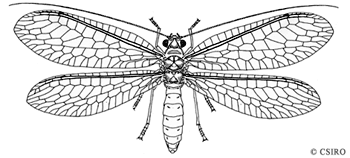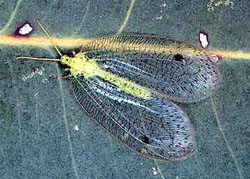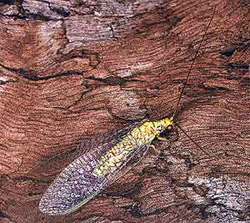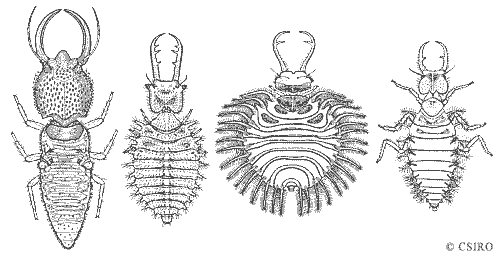|
Neuroptera:
lacewings and antlions
Characteristics
Lacewings
are delicate looking, soft bodied insects with a wingspan ranging
in size from 5 to 150 millimetres and a body up to 50 millimetres
in length. As their name suggests their wings appear lace-like with
many intricate veins across their entire surface. Lacewings can
be recognised by the following features:

Chrysopa species
|
|
- 2 pairs of
membranous
wings of relatively equal size
- Complex wing
venation with main vein forked along the bottom edge of the wing.
Wings are held tent-like over the body when at rest
- Often long,
filiform
antennae, which may be clubbed in some species
The larvae
of lacewings, many of which are commonly known as antlions, appear
very different from the adults and vary greatly in shape and size
depending on the species. The larvae
are grub-like with large jaws projecting from the front of the head,
which are used to seize their prey.
Lacewings may
be confused with dobsonflies
or alderflies (Megaloptera) but
can be distinguished from these insects by the presence of forked
veins. They may also be confused with stoneflies
(Plecoptera) and
dragonflies
(Odonata) but
lack the two thin abdominal cerci
that stoneflies possess and usually have longer antennae and softer
bodies than dragonflies.

Myiodactylus species (NYMPHIDAE)
|
Life Cycle
Mating
in lacewings is direct and females usually lay their eggs on or
in the substrate. Many species lay their eggs on the end of thin
stalks, which may be attached to wood, leaves or other surfaces
such as the windows and walls of houses. After hatching the larvae
moult
on average 3 times (sometimes 4 or 5 depending on the species) before
they spin a silken cocoon
in which to pupate.
Development is usually rapid and some species of lacewings have
several generations each year, although some species in colder areas
take up to 2 years to fully develop.
Feeding
Lacewings
are predatory
as both adults and larvae,
although some species of adults may supplement their diet with honeydew
or pollen. Adults mainly eat soft sap sucking insects such as aphids
and scale insects. Most larvae
are active predators
and have modified jaws, which they use to catch small insects and
suck out their insides. In the more arid regions you may have observed
the small pits of antlions, which are common in sandy areas. Small
insects stumble into the pit trap where they are grabbed and devoured
by the antlion who is waiting just below the surface.
|

Italochrysa insignis (CHRYSOPIDAE)
(green lacewing)
|
Habitat
Lacewings
are common throughout most of Australia and can be found in almost
all habitats. They are common on native vegetation, such as flowering
eucalyptus and in suburban gardens and homes. Many lacewings such
as the green lacewings (Chrysopidae) are often attracted to lights
at night and will release a strong smelling liquid when disturbed.
CHRYSOPIDAE
are known as the green lacewings and are characterised by having
long, filiform
antennae at least half as long as the forewings. Their wings have
many rectangular cells and their bodies are mostly green. Adults
are common throughout the year in many areas of the country with
Chrysopa being the most common genera in Australia. Members
of the family NYMPHIDAE
are found only on mainland Australia, Tasmania, Lord Howe Island
and in New Guinea. This is only a small family and the species are
most common along the east coast of Australia.
|




